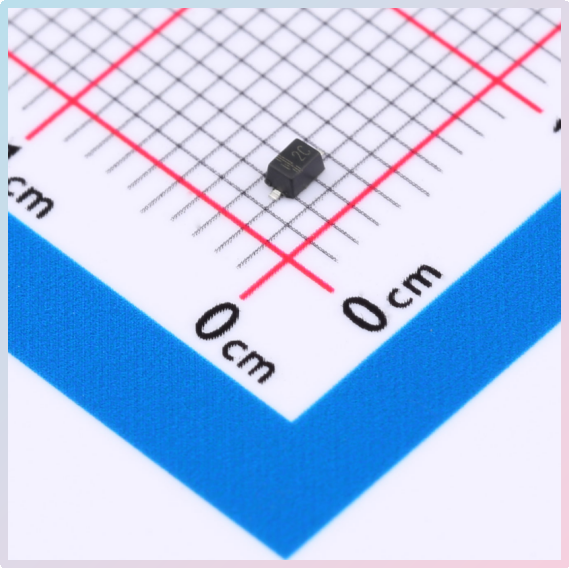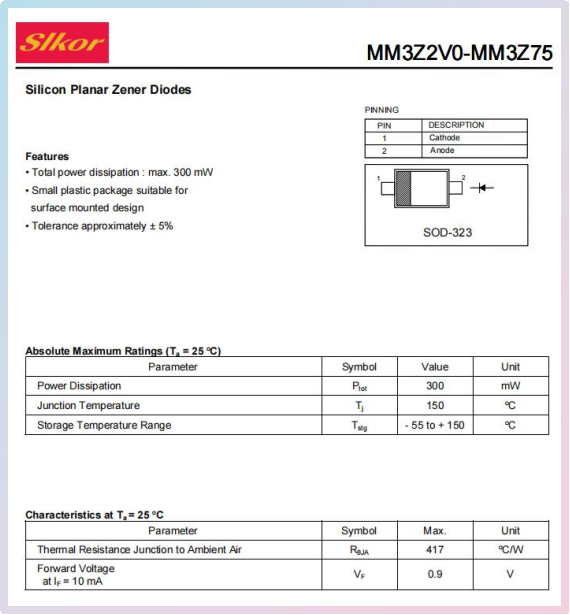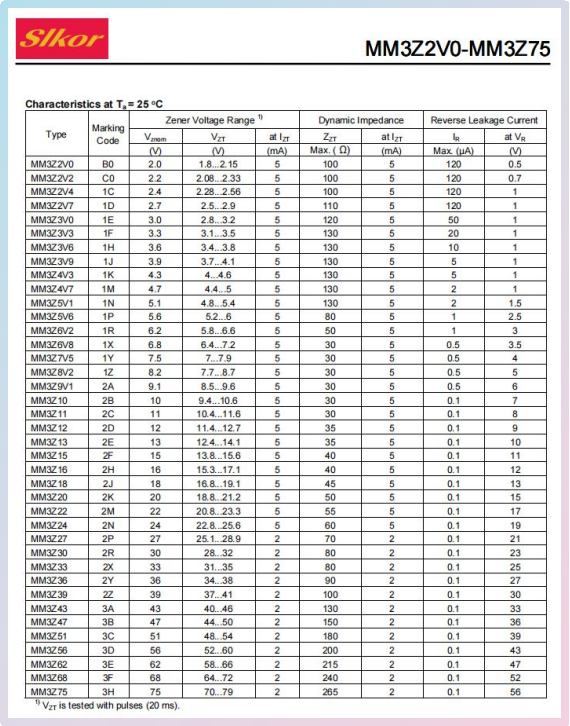Service hotline
+86 0755-83044319
release time:2024-07-15Author source:SlkorBrowse:11945
In the field of electronics, Zener diodes play a crucial role, especially in voltage regulation and circuit protection. Today, we delve into a high-performance Zener diode — the MM3Z11 — renowned for its excellent regulation characteristics and reliability, standing out in numerous electronic applications.

Slkor Voltage Regulator Diode MM3Z11 product photo
The MM3Z11 Zener diode is designed for stand-alone configuration, allowing flexible integration into various circuit designs without additional external components. This design simplifies circuit layout, reduces costs, and enhances overall system reliability.
The MM3Z11 has a nominal Zener voltage of 11V, with a regulation range between 10.4V to 11.6V. This broad regulation range enables stable operation under various power supply voltages, providing continuous and reliable voltage output for electronic devices. Such stability is critical for ensuring normal circuit operation, especially in environments with significant power supply fluctuations or interference.
Rated at 300mW, this diode effectively manages power consumption while maintaining performance. Power management is crucial in electronic devices, directly impacting battery life and long-term stability. The MM3Z11 excels in this regard, laying a solid foundation for the design of high-efficiency electronic devices.
At 8V, the reverse current of the MM3Z11 is only 100nA, indicating high resistance and effectively reducing unnecessary current loss. Furthermore, its impedance is 30Ω, providing stable resistance within the circuit, further enhancing stability and efficiency.

Slkor Voltage Regulator Diode MM3Z11 specification

Parameters of Slkor Voltage Regulator Diode MM3Z11
The low reverse current of the MM3Z11 is crucial for circuit stability, particularly in the following aspects:
Firstly, low reverse current minimizes leakage current when the diode is in reverse bias. This feature helps reduce circuit leakage, which can otherwise lead to energy wastage and unnecessary heat generation, affecting circuit stability and longevity. The MM3Z11's low reverse current capability mitigates these adverse effects.
Secondly, low reverse current contributes to improved circuit signal-to-noise ratio. In signal processing circuits, any unexpected current can introduce noise, interfering with the transmission and processing of useful signals. By lowering reverse current, the MM3Z11 reduces the source of such noise, thereby enhancing signal clarity and accuracy.
Moreover, low reverse current implies higher impedance when the diode is in reverse bias. High impedance effectively isolates different parts of the circuit, preventing unnecessary current flow between sections. This is crucial for maintaining circuit stability and preventing potential faults.
Low reverse current plays a critical role in improving circuit signal-to-noise ratio. Signal-to-noise ratio (SNR) is a vital metric for assessing signal quality, defined as the ratio of signal power to noise power. In circuits, any current not originating from the signal source can introduce additional noise, which interferes with useful signal transmission and processing, thereby reducing SNR and affecting circuit performance.
During operation, if a Zener diode exhibits high reverse current, it can become a noise source itself. This occurs because reverse current causes random movement of internal charges within the diode, generating current noise that adds to the useful signal, causing signal distortion or reducing clarity.
In contrast, low reverse current means the current flowing through the diode in reverse bias is minimal. Consequently, noise generated by the diode itself is significantly reduced. Reduced noise translates to reduced interference during signal transmission, allowing useful signals to be transmitted and processed more clearly.
Therefore, a Zener diode like the MM3Z11, with its low reverse current capability, effectively reduces self-generated noise, thereby improving circuit signal-to-noise ratio. This enhancement enables circuits to perform better in applications requiring transmission of weak signals or high-precision signal handling, ensuring signal accuracy and reliability.
Slkor has research and development offices in Busan, South Korea, Beijing, China, and Suzhou, China. Most of the wafer manufacturing and packaging and testing are carried out within China. The company employs and collaborates with individuals and organizations worldwide, with a laboratory for product performance and reliability testing and a central warehouse located at its headquarters in Shenzhen. Slkor has filed for over a hundred invention patents, offers more than 2,000 product models, and serves over ten thousand customers globally. Its products are exported to countries and regions including Europe, the Americas, Southeast Asia, and the Middle East, making it one of the rapidly growing semiconductor companies in recent years. With well-established management systems and streamlined workflows, Slkor has rapidly enhanced the brand awareness and reputation of its "SLKOR" brand through its outstanding quality and standardized services. Its product range includes three major series: diodes, transistors, and power devices, with recent introductions of new products such as Hall elements and analog devices, expanding its presence in sensors, Risc-v microcontrollers, and other product categories.









Site Map | 萨科微 | 金航标 | Slkor | Kinghelm
RU | FR | DE | IT | ES | PT | JA | KO | AR | TR | TH | MS | VI | MG | FA | ZH-TW | HR | BG | SD| GD | SN | SM | PS | LB | KY | KU | HAW | CO | AM | UZ | TG | SU | ST | ML | KK | NY | ZU | YO | TE | TA | SO| PA| NE | MN | MI | LA | LO | KM | KN
| JW | IG | HMN | HA | EO | CEB | BS | BN | UR | HT | KA | EU | AZ | HY | YI |MK | IS | BE | CY | GA | SW | SV | AF | FA | TR | TH | MT | HU | GL | ET | NL | DA | CS | FI | EL | HI | NO | PL | RO | CA | TL | IW | LV | ID | LT | SR | SQ | SL | UK
Copyright ©2015-2025 Shenzhen Slkor Micro Semicon Co., Ltd